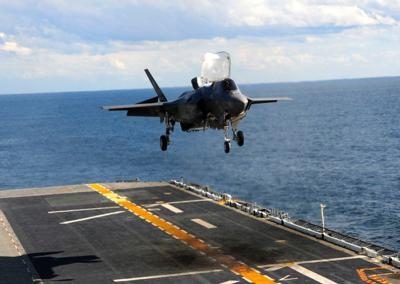F135 On Track For US Marine Corps F-35 Initial Operational Capability
Pratt & Whitney powered the first shipboard Marine Corps F-35B operational test from the USS Wasp from May 18-29 off the coasts of Virginia and North Carolina. Four F-35B aircraft from Marine Fighter Attack Squadron 121 and two F-35B aircraft from Marine Fighter Attack Squadron 501 performed more than 100 short takeoffs and vertical landings, with nearly flawless performance from the F135 propulsion system during the 10 day sea trials.

"We are delighted with the exceptional performance of the F135 during OT-1, and are proud to partner with the U.S. Marine Corp on this important program," said Mark Buongiorno, vice president, F135 Propulsion System, Pratt & Whitney. "OT-1's successful completion provides valuable insight and confidence in the engine as the Marine Corps Initial Operating Capability (IOC) approaches."
The Marines were able to safely execute day and night flight operations; conduct scheduled and unscheduled day and night maintenance activities; at sea-staging of engine and lift fan removal and installation; confirm the suitability of F-35B maintenance support equipment for shipboard operations; and prove the feasibility of the logistics footprint of a six-plane F-35B detachment aboard a U.S. Navy amphibious ship.
OT-1 also marked the first time that an F135 power module, the largest and heaviest part of the F-35B's engine, was transported using a shipping system designed and manufactured by Pratt & Whitney and RENO Machine Tool of Newington, CT. There was previously no way to transport replacement power modules.

Pratt & Whitney, in partnership with Bell Boeing, overcame the engineering and logistical obstacles of transporting the module and its specially designed protective carrier from shore to ship using an MV-22B Osprey. Combined, the two weigh nearly 9,000 pounds.
"With the declaration of USMC IOC rapidly approaching, the ability to conduct underway resupply of a F135 power module is crucial to F-35 logistical sustainment," said Lt. Gen. Jon Davis, U.S. Marine Corps Deputy Commandant for Aviation. "Furthermore, as the U.S. Navy replaces their Carrier On-Board Delivery aircraft with the V-22, this new capability will enable them to resupply all aircraft carriers and big deck amphibious carriers with both F-35B and F-35C power modules."
Lowering the power module to the ship's maintenance bay, and proving the ability to safely transfer the module was accomplished by personnel from Marine Operational Test and Evaluation Squadron 22.

"We know that we can now put a power module into an MV-22B and bring it out to an amphibious vessel," said Jeff Ward, who is in charge of F-35B deployment integration with Headquarters Marine Corps, in a US Marine Corps release. "We can now resupply the Marine Corps, Navy and Air Force in any environment by using the MV-22B. This is an important milestone for the program."
P&W powers the F-35 Lightning II with the F135 propulsion system which has logged more than 5,700 flights, 21,000 flight hours and more than 800 vertical landings. To date, Pratt & Whitney has delivered 228 F135 engines, including both System Design and Development and production engines.
(Images from file)
 ANN's Daily Aero-Linx (05.02.24)
ANN's Daily Aero-Linx (05.02.24) ANN's Daily Aero-Term (05.02.24): Touchdown Zone Lighting
ANN's Daily Aero-Term (05.02.24): Touchdown Zone Lighting Aero-News: Quote of the Day (05.02.24)
Aero-News: Quote of the Day (05.02.24) ANN FAQ: Contributing To Aero-TV
ANN FAQ: Contributing To Aero-TV NTSB Final Report: Cirrus Design Corp SR20
NTSB Final Report: Cirrus Design Corp SR20





